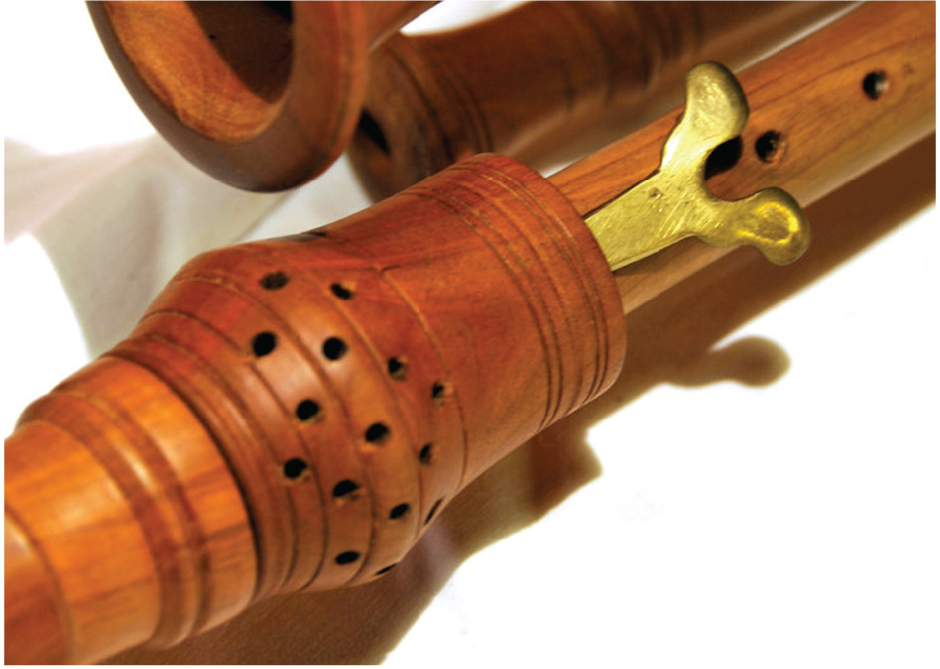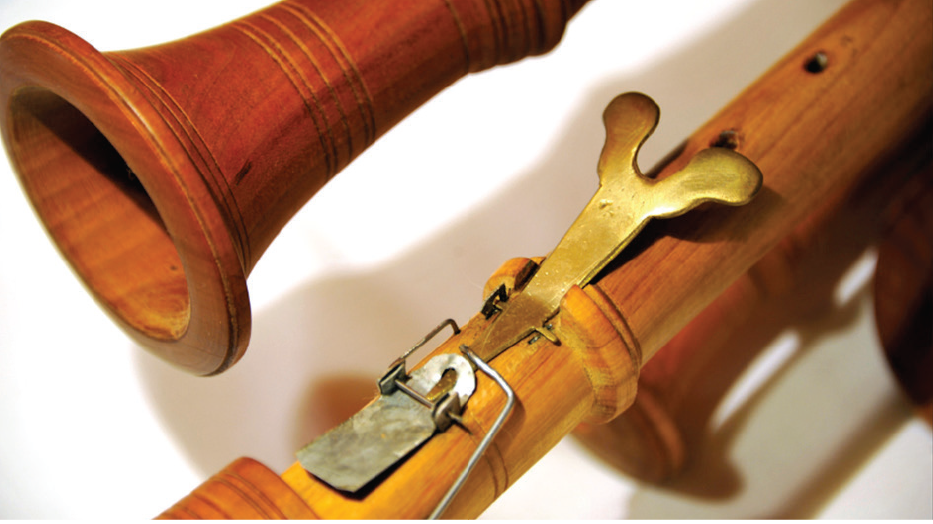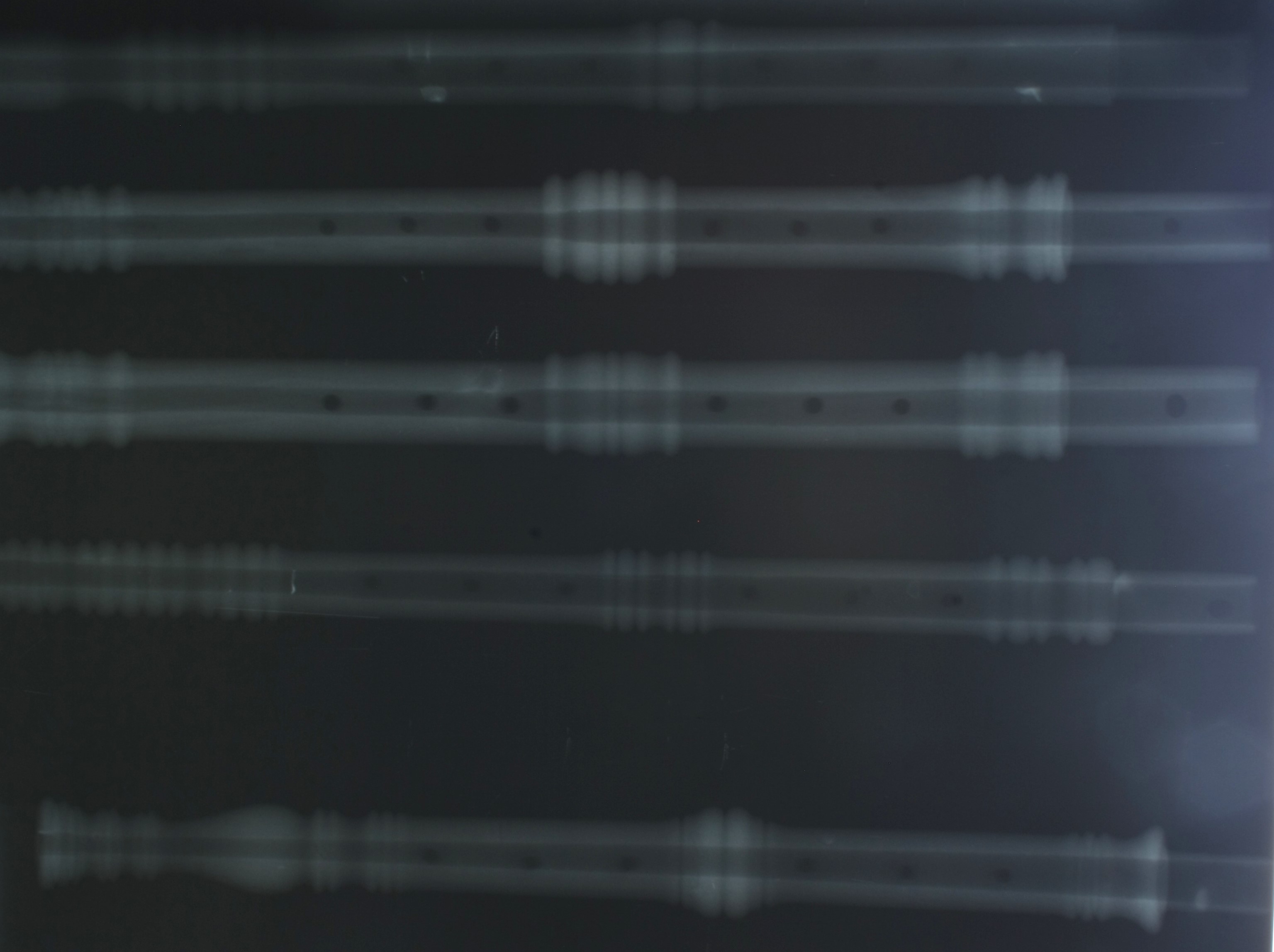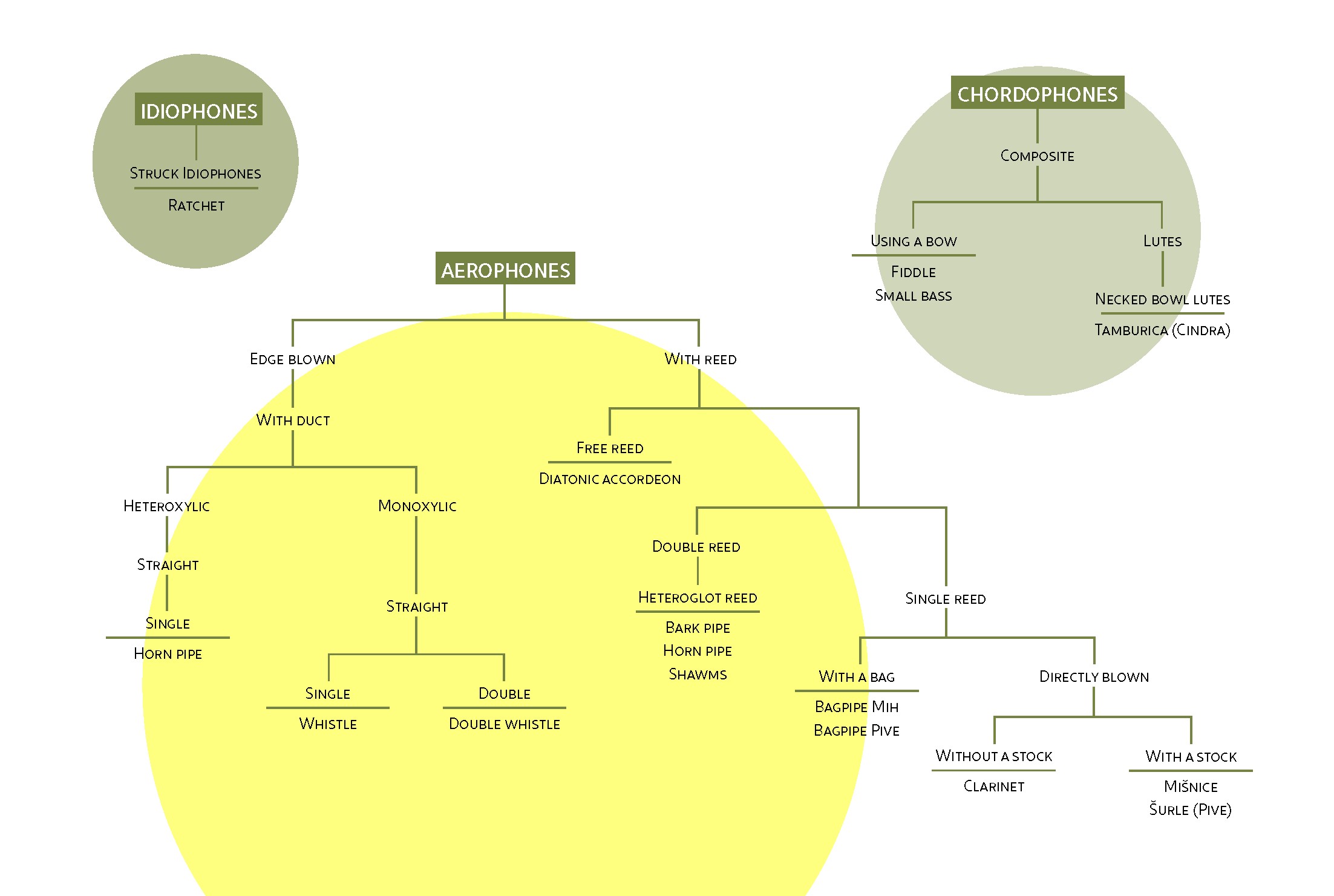About the traditional instruments in Istria and analysis methodology of intruments
Musical instruments are tools in the real sense of the word. Thought, made or adapted to assist man in the creation of music, and especially all those sounds that the human body is unable to produce independently. By themselves, the instruments are part of the material culture, but their function to create music is intangible. Ethnomusicology and its specific area – ethno-organology (1), significantly expanded our understanding of instruments. According to Stockmann, a musical instrument is any object with which we deliberately produce sounds that for us have the meaning of music. The origin of the original intention of using an object loses all meaning when specific, desired and organized sounds are produced with this object. A specifically traditional musical instrument can become any instrument on which players play in conditions that fall under the traditional context and each object which they use in that context determines the purpose of the instrument.
Musical instruments are without doubt complex objects, either ergologically (2) or technologically, aesthetically, by acoustic possibilities and playing technique, as well as by function, terminology or symbolic meaning. The first written testimony concerning Istrian musical instruments dates back to the 17th century, when G.F. Tommasini described the wedding and dance to the sounds of shawm, violin and guitar. In addition to written sources we often trust iconographic sources too. Although those, from the ethnomusicological point of view are only partly credible, since they were mostly the result of transferring of already existing motives, we should keep in mind that these motives are often modified to the taste inherent in a particular area. In this sense, in presenting the instruments we should take into account that possibly slight connection to the Istrian musical reality of the same period, which hypothetically could have affected the artists.
 Part of a Renaissance shawm; resemblance to same part of the sopela.
Part of a Renaissance shawm; resemblance to same part of the sopela.
The third essential component in the study of musical instruments is their terminology. In Southern Istria wind instruments prevail, and it can be assumed that in the past the dominance extended to the north. In these areas, in fact, most of the popular names that indicate the playing ares linked to the logic of brass. On Buzeština the general term for playing is sopet (literally blow), without taking into account whether it is a clarinet, a fiddle or a bajs (small double bass). In the area of Buje, in part of the Kopar area and in Ćićarija the term in use is piskat (to beep), and even if its literal meaning is to play a wind instruments, it is also used for the violin, tamburitza, drum and guitar. Detailed study of the popular terminology is sometimes critical to identifying instruments. Different instruments are often hidden under one name, or vice versa, one instrument can be labelled with more names. Pišćala can denote the clarinet, the flute or the kazoo; the roženice can be sopele, or the chanter of two types of bagpipes (3).
Over time, various names are passed from one musical instrument to another; they merge, disappear and new ones occur. This happens not only in the spatial principle, but also within one and the same community, and even in the same informant who, calling an instrument a name, later claims that the instrument is called differently (4).
Despite a high number of copies of musical instruments in the holdings of the Ethnographic Museum of Istria, it should be noted that in terms of typology they only partially represent a much larger number of types of instruments recorded on the field. This is largely the result of a poor methodological approach that was already obsolete at the beginning of the collecting process. In the absence of native ethnomusicologist, those who dealt with the Istrian musical heritage in the past were mostly journalists and music teachers or experts of extra-Istrian origin, reluctant in the understanding of the often multi-layered and trans-cultural Istrian reality, which is a product of centuries of mutual influence. (5)
 Detail of the flap of a Renaissance shawm.
Detail of the flap of a Renaissance shawm.
In such a climate one of the major misconceptions about the age and origin of the sopela was shaped. Although already in the 1930s, the then most prominent Croatian organologist Božidar Širola, came to the undeniable conclusion on the non-Istrian origin of the instrument (6), the poetic metaphor of Mate Balota about sopele that "play thousands of years" became an anti-scientific proof, a quite liberal measure. With this yardstick it was very easy to raise the sopele as the instrument that was “always” played in Istria. It is therefore understandable that the players, flattered by this, connected the sopele with the immemorial, even at the expense of the Istrian bagpipe (mih) which has undoubtedly older features. But until recent times, the mih was too often a "banal" instrument, almost always made by the very musicians who played it, therefore, on a symbolic level, devoid of virtuoso opportunities and, most importantly, not lofty and festive. (7)
With the exception of simple instruments, such as sorts of reed flutes, extremely interesting from an ethno-organological aspect, which is probably due to the lack of understanding of their role and importance in everyday music-making of individuals (8), the ignoring of the violin and bajs, diatonic accordion, harmonica (9) or cindra (10) (zither like instrument) by the then researchers and curators is completely unacceptable.
Of the instruments from the collection of the Ethnographic Museum of Istria, the most represented are aerophones, mostly sopele (shawms) (11),mišnice and mih (bagpipes), šurle, dvojnice (twin or double whistles), sopelica, horn, reed pipes made of bark, a clarinet and a diatonic accordion. The cordophones are represented by a fiddle, a bajs (two stringed small double bass) and a cindra. The idiophones are represented only by a ratchet. Precise measurements and photo documentation were made again for all the instruments, while the sopele were also subjected to radiography. New measurements have shown that the instruments of the same type due to intentional or accidental, even minimal deviations in size are in a way, unique. Regarding the sopele the X-ray showed however that in most instruments the conicality of the inner tubes is truly relative so a better definition for them would be: stepped-drilled tubes with rounded edges.
 X-ray image of the sopele from the museum holdings, 2012. From the EMI / MEI documentation.
X-ray image of the sopele from the museum holdings, 2012. From the EMI / MEI documentation.
Therefore, during the measurement process not only the dimensions that to some extent describe the appearance of the instrument were shown, but we also tried to take into account all the material parameters that affect the acoustic result of a particular instrument. This effort, however, achieved only a partial success, given that for the majority of instruments the most important part is missing or unusable – and that is the mouthpiece. That is why, as the next phase, we plan further experimental measurements of the acoustic properties of each instrument.
On top of all, the estimation of the quality of an instrument is only possible if we appreciate the historical memory of determined norms and mechanisms which govern within a community and that normally determine the mode of transmission of knowledge and its formalization. Success in the crafting of a traditional instrument is the result of individual abilities of technical thinking and manual skills of each maker, and the continuation of tradition in the frame of expectations of a community. In the end, the most successful makers are the ones who manage to combine some formal and symbolic appearance of the instrument while predicting and realizing its acoustic functionality.
 Musical instruments from EMI/MEI museum collection according to Hornbostel-Sachs classification from 1914.
Musical instruments from EMI/MEI museum collection according to Hornbostel-Sachs classification from 1914.
Footnotes:
1. Ethnoorganology – the science dealing with the study of traditional musical instruments.
2. In our case, the term includes the maker’s relationship to the act of making a certain instrument.
3. The name roženice used for sopele could be mediated via the bagpipe (Cornamusa> corno = rog (horn)> roženice). The name is in fact widespread only in the south of Istria, in other parts the reed-pipes are called sopela or sopel. Valvazor’s rozheniza found in central Istria could possibly be a bagpipe.
4. "Moreover, for the famous Istrian roženice, their maker Anton Peteh claims that they are not called roženice but sopiele, and that the roženice are what someone calls šurle. It also happens that the same narrator, who in 1957 said that the instrument is called šurla, today says that its name is tutula and that šurla is something else. "(Ivančan, 1960)
5. While insisting on any trace that could point to the most ancient possible indigenous national (Croatian or Slovenian) presence in the area, at the same time, regardless of its rich tradition, the Italian cultural element was minimized or completely omitted even where it was prevalent. Even today, sometimes we find division: Istrian music (by which is meant Croatian music) and the music of the Italian ethnic community. This division is quite tendentious, because it suggests that the music "of the Italian ethnic community" is not Istrian.
6. If we accept the thesis that the current sopele arrived in Istria in the Renaissance as the shawm, we cannot rule out the possibility that they replaced previous, less perfected or similar instruments. All older specimens of instruments in the Istrian museums are relatively recent. The oldest instrument is a sopela made in the 1920s.
7. The mih is the instrument that more than any other reflects the likely development path to the Istrian two-part singing in narrow intervals. Comparing it to other similar instruments in Croatia and Bosnia and Herzegovina, it can be determined that it has a completely distinctive arrangement of the holes, following the development of vocal music and maybe having a retroactive impact on her.
8. Those are the instruments that should be investigated because they often represent older substratum of double clarinets (mišnice, šurle) developed in an organological way.
9. Otherwise, the most common and, sometimes, the only instruments in most of Istria. The violin and the bajs, the diatonic accordion, clarinet and cindra from the holdings of the EMI, were obtained only in 2000.
10 Eventual confirmations for the possible transformational path of bugarenje (untempered singing) can linked to the cindra from Ćićarija. Because of the special distribution of the frets on the neck, which are set at the same distance from one another, intervals of the same tunes, played before grabbing the same in different parts of the neck, are different. It is clear that, when you play on the lower part of the neck, intervals are narrower than when you play on the upper part. There are two usual ways of playing - in a low and in a high position. The low position accompanies bugarenje in the narrow sense, while the high position accompanies dancing and kantanje (singing).
11. The sopele from Istria should be separated from the sopile from the island of Krk, in geographical terms and also in terms of organology and consider them similar but different instruments.